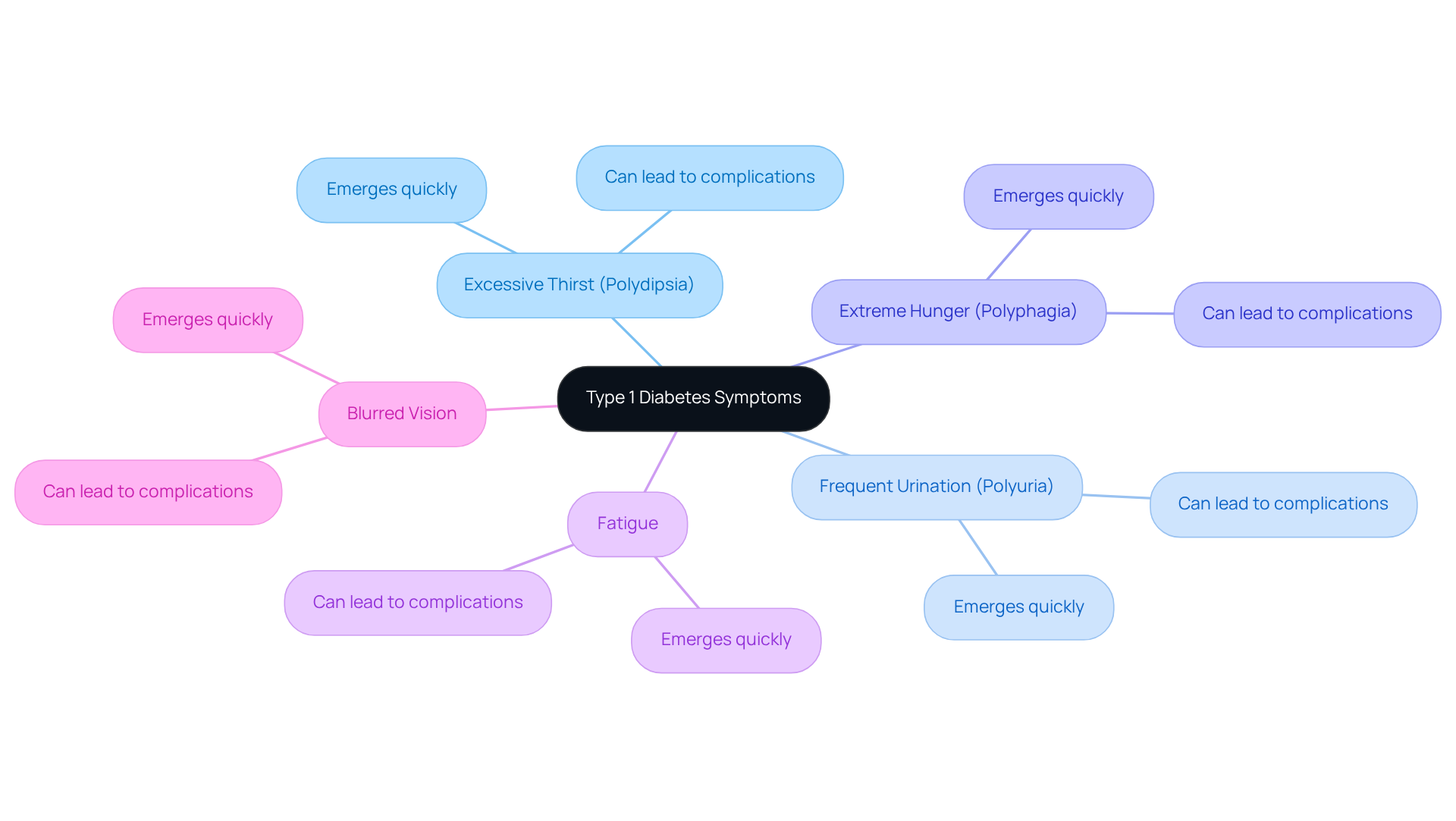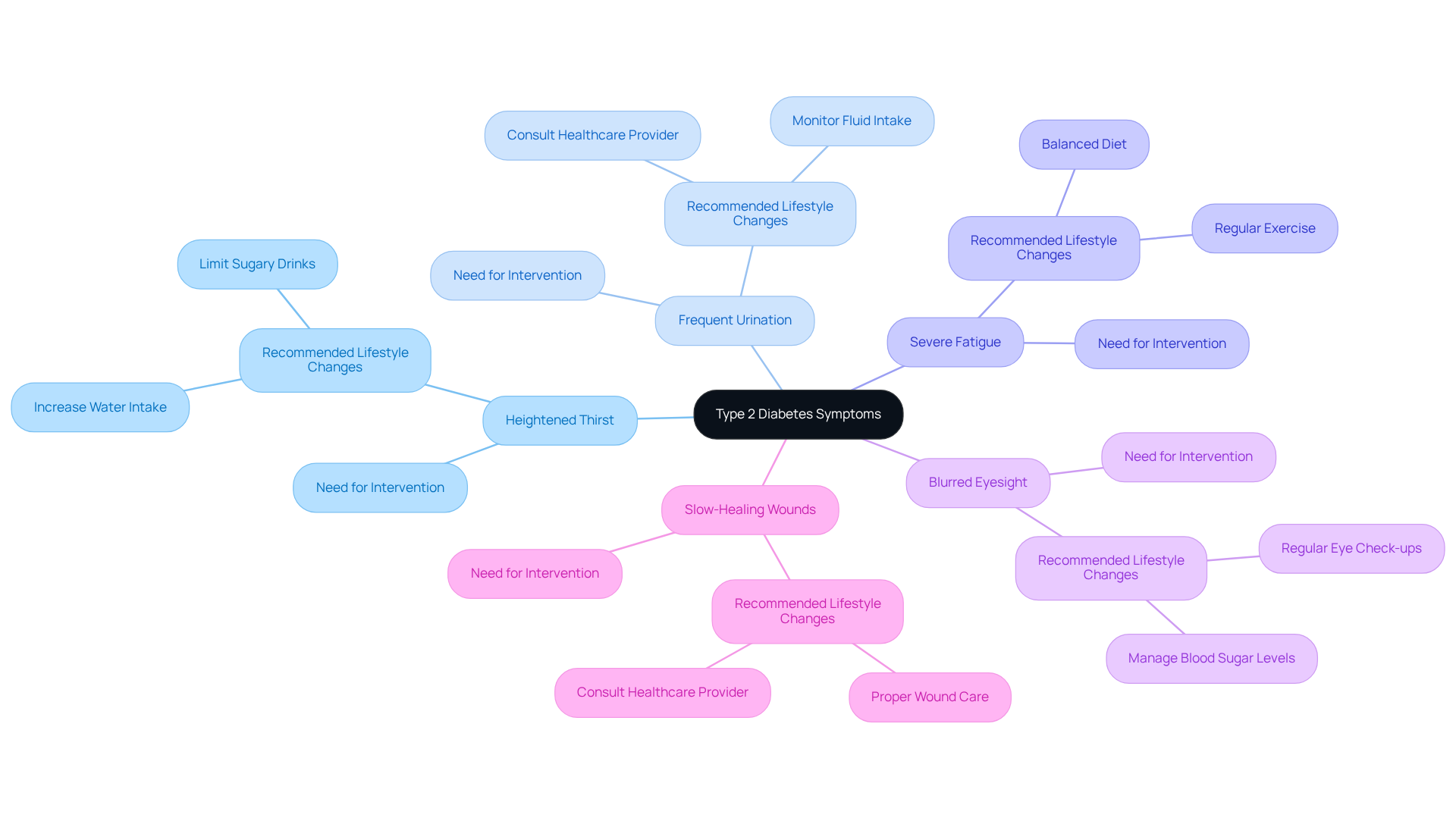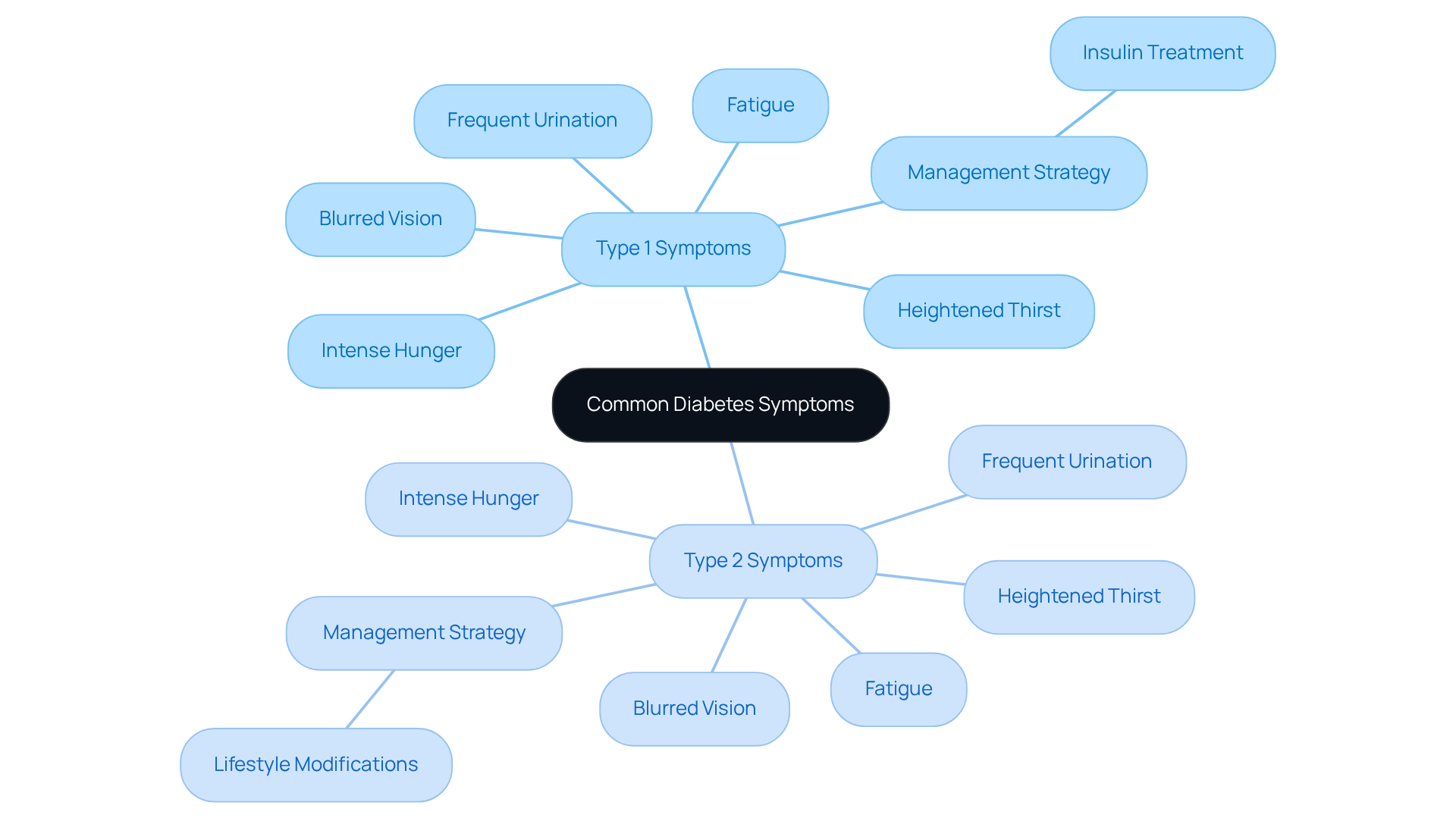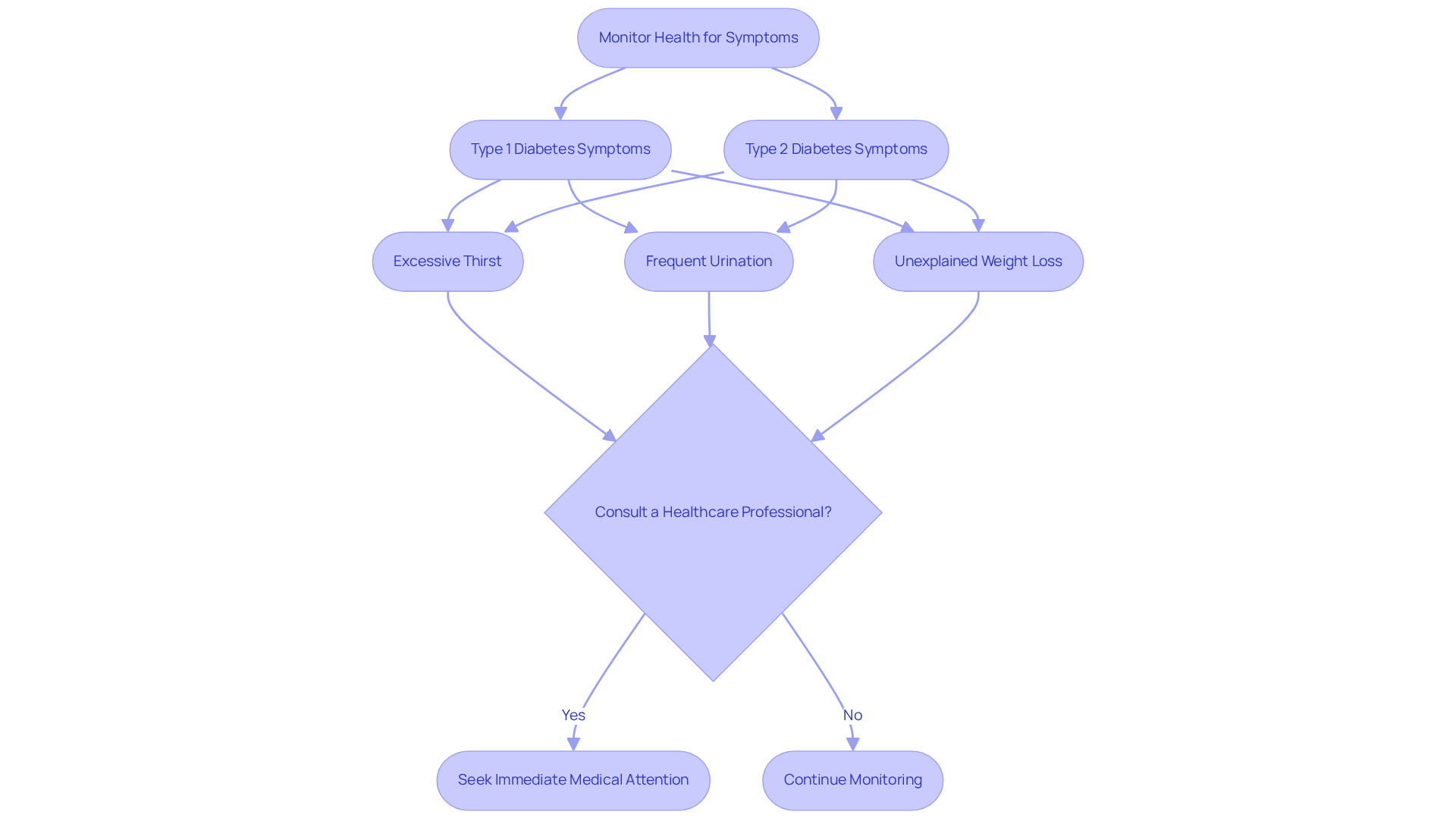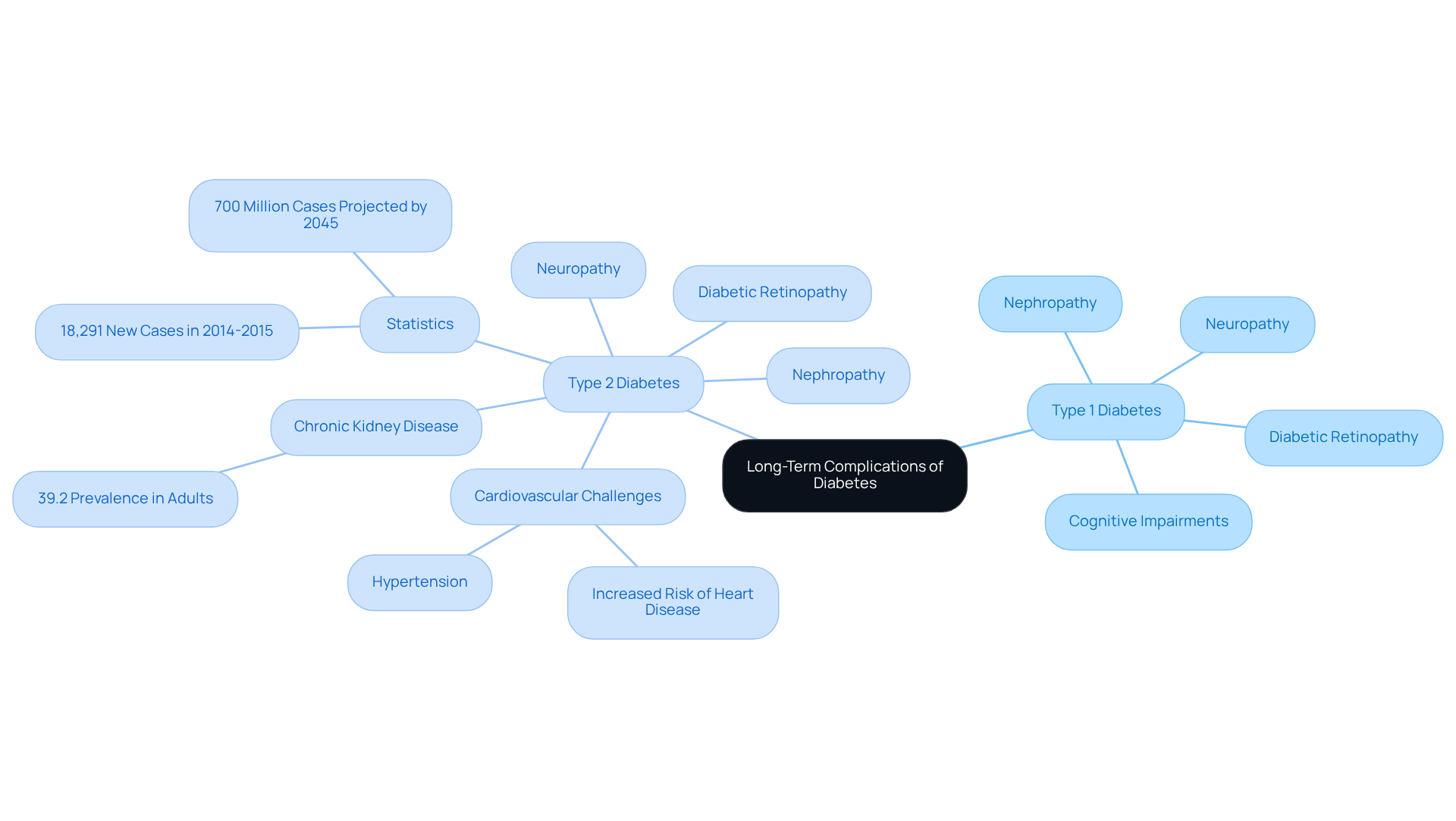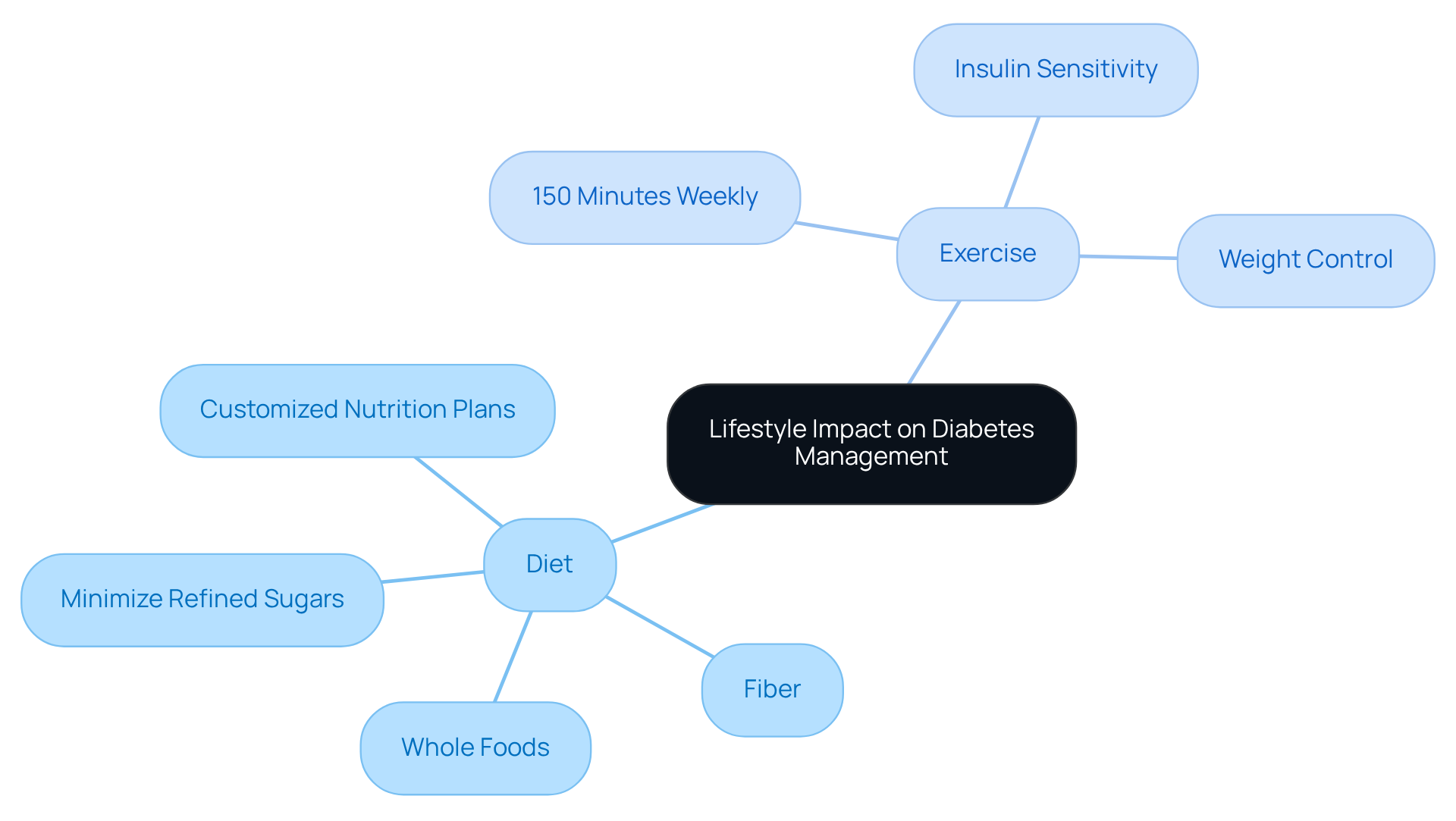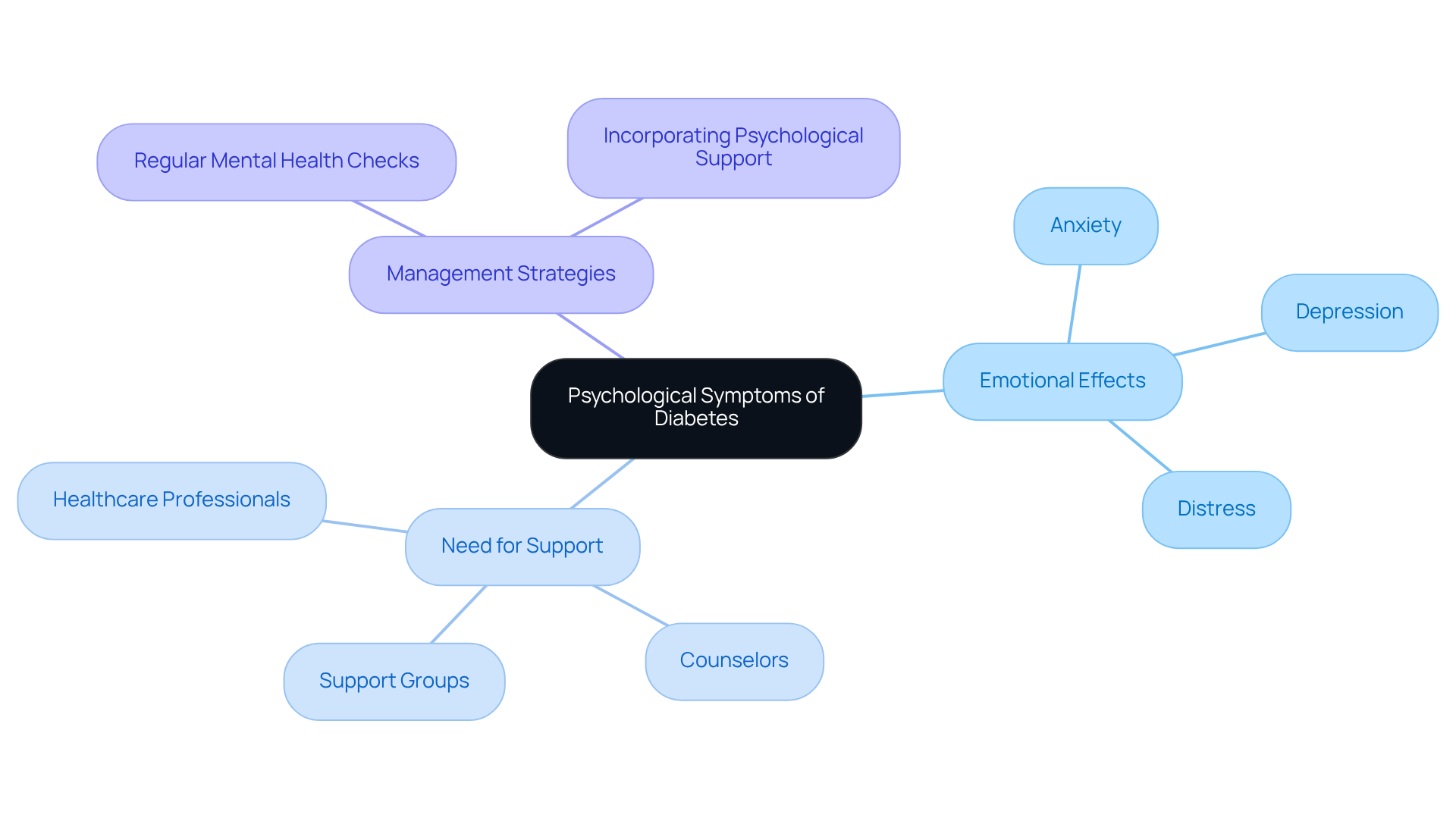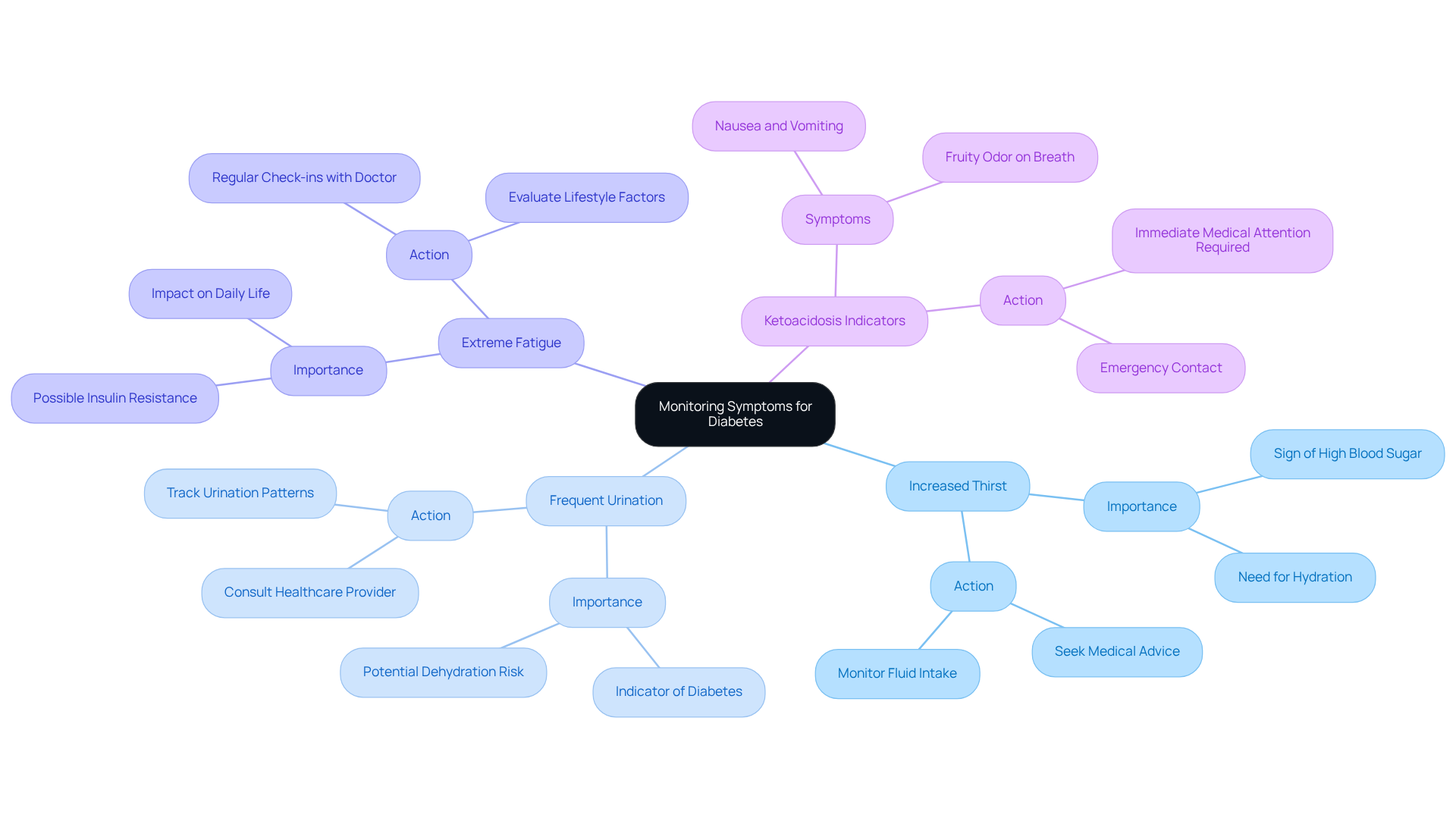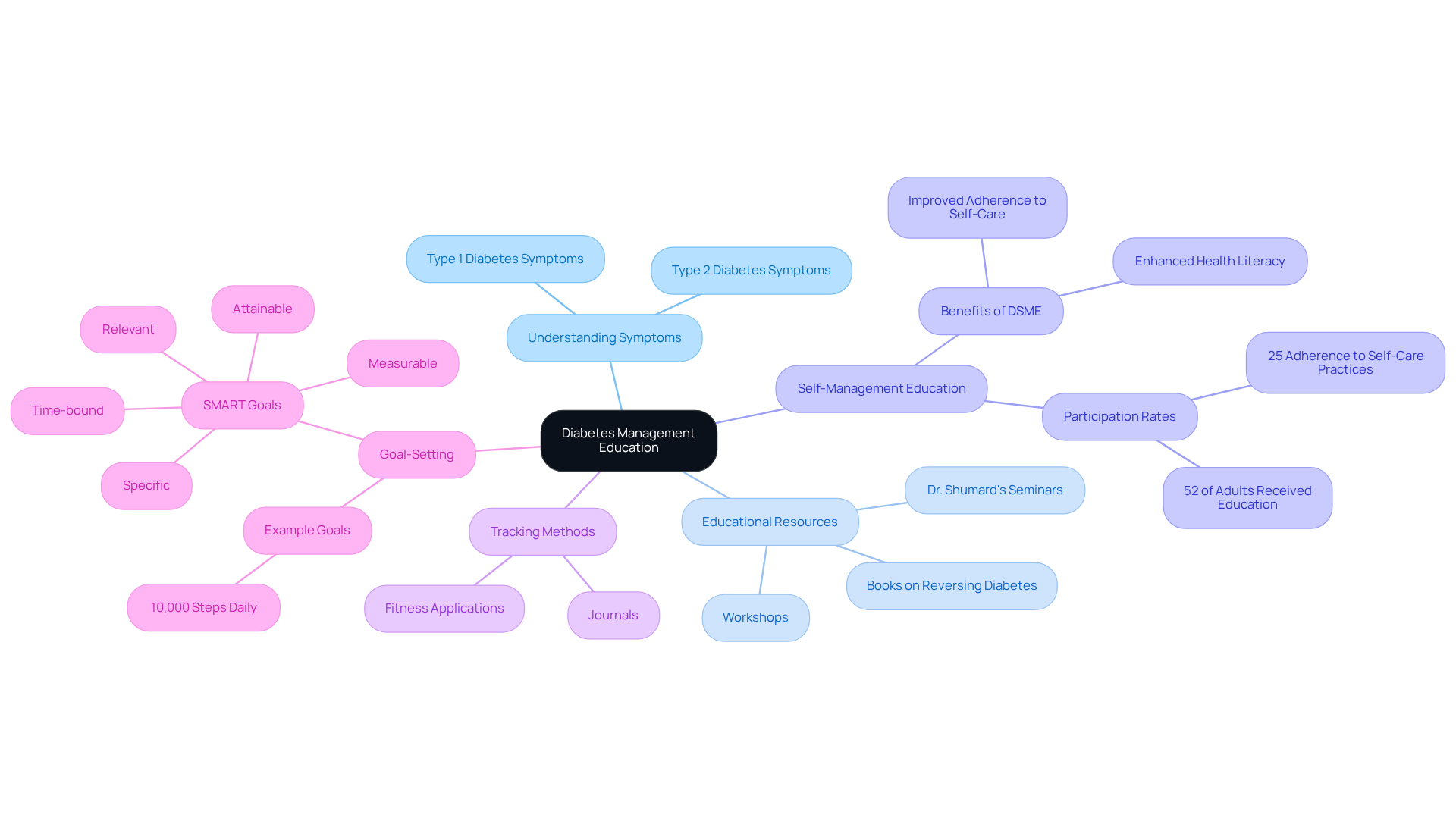Overview
This article highlights the important differences in symptoms between Type 1 and Type 2 diabetes, acknowledging the challenges faced by those living with these conditions. While both types share common symptoms, such as excessive thirst and fatigue, it’s crucial to understand that their onset and progression can differ significantly.
Many patients find that Type 1 diabetes symptoms often appear suddenly, necessitating immediate medical attention. In contrast, Type 2 diabetes symptoms tend to develop gradually, which can sometimes lead to misdiagnosis and delayed treatment if not recognized early.
It’s essential to be aware of these differences to seek timely help and support.
Introduction
Understanding the nuances between Type 1 and Type 2 diabetes symptoms is crucial for effective management and early intervention. Many individuals find themselves grappling with overlapping signs such as excessive thirst and fatigue. This can make it challenging to distinguish between the two conditions, leading to misdiagnosis and inadequate treatment. It’s important to recognize that these struggles are common, and you are not alone in this journey.
This article delves into the key differences in symptoms, providing insights that empower you to recognize early warning signs. By understanding these distinctions, you can take proactive steps toward better health. How might this knowledge transform your approach to managing diabetes and enhance your overall well-being? Together, we can explore these vital insights and support you in your journey toward a healthier life.
Integrative Wellness Center: 30-Day Diabetes Reset Program for Symptom Management
Are you struggling to manage your health and feeling overwhelmed? The 30-Day Reset Program at the Integrative Wellness Center is here to support you. This compassionate program is designed to equip you with essential tools and knowledge for effectively managing your condition. Focusing on individualized coaching, nutritional advice, and behavior change methods, it aims to reverse diabetes type 1 and 2 symptoms.
Many participants find that adopting sustainable lifestyle changes can significantly enhance their wellness outcomes while reducing dependence on medication. Through educational materials, including workshops and complimentary copies of books authored by Dr. Jason Shumard, you will gain a deeper understanding of how to manage your blood sugar levels. This knowledge directly aligns with the program’s objectives, fostering a sense of empowerment in your wellness journey.
Testimonials from participants highlight the program’s transformative effects. Many express newfound confidence, reporting that they have stabilized their glucose levels without relying on insulin or prescription drugs. They experience renewed energy and a reduction in the anxiety often associated with potential complications of their condition. It’s important to recognize that this comprehensive strategy corresponds with recent discoveries emphasizing the significance of individualized coaching in managing diabetes type 1 and 2 symptoms.
Notably, statistics reveal that similar programs have achieved impressive completion rates, with 960 (55%) of participants in the NHS T2DR program successfully completing it. This underscores the potential for positive outcomes in your health journey.
Are you ready to take the next step? Contact us today to learn more about how the 30-Day Diabetes Reset Program can transform your health journey.
Type 1 Diabetes Symptoms: Early Warning Signs to Recognize
It’s important to recognize that common early warning indicators of form 1 blood sugar disorder can significantly impact your daily life. Excessive thirst (polydipsia), frequent urination (polyuria), extreme hunger (polyphagia), fatigue, and blurred vision are all diabetes type 1 and 2 symptoms you may experience. These signs can emerge quickly, often within just a few days or weeks, which can be quite alarming.
Many patients find that if these indicators are neglected, form 1 of the condition can lead to severe complications, such as diabetic ketoacidosis (DKA), requiring prompt medical care. Understanding these signs is essential, especially for individuals with a family background of glucose intolerance. By recognizing these symptoms early, you can take proactive steps toward better health and well-being.
Type 2 Diabetes Symptoms: Key Indicators You Shouldn’t Ignore
It’s important to recognize that the essential signs of diabetes type 1 and 2 symptoms can often be subtle. Heightened thirst, frequent urination, severe fatigue, blurred eyesight, and slow-healing wounds may not seem alarming at first, yet they are all indicative of diabetes type 1 and 2 symptoms. Unlike diabetes type 1 and 2 symptoms, the signs of diabetes type 2 often develop slowly, making them easy to overlook or attribute to normal aging or other health issues. Many patients find that they are unaware of their condition—research indicates that nearly 25 percent of those affected do not realize they have it. This highlights the critical need for vigilance in recognizing these signs.
Timely intervention can greatly enhance health outcomes. You may be surprised to learn that lifestyle modifications can reduce the likelihood of progressing from prediabetes to a second stage of glucose intolerance by as much as 58 percent. Seeking advice from healthcare experts for appropriate assessment and management is crucial. Remember, prompt intervention can lead to an improved quality of life and fewer complications related to the condition. Taking that first step toward understanding your health can make all the difference.
Common Diabetes Symptoms: Overlapping Signs of Type 1 and Type 2
Living with a condition that presents common signs like heightened thirst, frequent urination, intense hunger, fatigue, and blurred vision, which are all considered diabetes type 1 and 2 symptoms, can be incredibly challenging. It’s important to recognize that these overlapping diabetes type 1 and 2 symptoms may cause uncertainty about the specific type of condition one might have. Research shows that nearly 25% of individuals with diabetes are unaware of their condition, which highlights the crucial need for awareness of these signs to ensure timely diagnosis and appropriate treatment.
Many patients find that misdiagnosis can lead to insufficient management strategies. For instance:
- Category 1 typically requires insulin treatment.
- Category 2 often focuses on lifestyle modifications and addressing underlying health issues.
This distinction is vital for effective care. Recent studies reveal that misunderstandings between these two categories are particularly prevalent among certain demographics, underscoring the necessity for targeted education and awareness programs.
Grasping the diabetes type 1 and 2 symptoms is essential for managing the condition effectively. By identifying the symptoms accurately, individuals can receive customized care strategies that truly meet their needs. Remember, you are not alone in this journey, and understanding your condition is the first step toward taking control of your health.
Onset of Symptoms: How Type 1 and Type 2 Diabetes Differ
The onset of insulin-dependent conditions can feel sudden and overwhelming, often emerging with intensity within just a few days to weeks. In contrast, the signs of stage 2 sugar metabolism issues tend to develop more gradually, frequently remaining unnoticed for years. This significant difference in how symptoms appear highlights the urgent need for timely medical attention.
Given the recent concerns about hospital safety, including the troubling rise in medication errors and infections, it’s crucial to be vigilant. If you or someone you know experiences rapid changes in health, it’s essential to consult a medical professional to rule out diabetes type 1 and 2 symptoms, particularly when common signs like excessive thirst, frequent urination, and unexplained weight loss are present.
Recent research indicates that early detection and intervention can significantly improve long-term health outcomes, making it vital to be aware of the diabetes type 1 and 2 symptoms. Each year, approximately 352,000 Americans under the age of 20 are diagnosed with this condition, underscoring the importance of recognizing these signs.
As Alexandra Mulvey poignantly states, ‘Despite all the progress in managing the disease, our community’s needs are growing and the need to respond is even more urgent today.’ By monitoring your health for these specific symptoms and seeking guidance from a healthcare provider when rapid changes occur, you can take proactive steps in managing your well-being.
Consider exploring personalized functional medicine approaches that prioritize tailored nutrition and testing, as these can empower you on your journey to better health.
Long-Term Complications: Distinct Symptoms of Type 1 vs. Type 2 Diabetes
Long-term issues associated with this illness can differ significantly when considering the diabetes type 1 and 2 symptoms. It’s important to recognize that diabetes type 1 and 2 symptoms are often linked to complications like:
- Diabetic retinopathy
- Nephropathy
- Neuropathy
These complications arise from prolonged high blood sugar levels. However, many patients find that the diabetes type 1 and 2 symptoms introduce even more serious risks. Individuals experiencing diabetes type 1 and 2 symptoms frequently face cardiovascular challenges, which can be exacerbated by related conditions such as obesity and hypertension.
Recent studies indicate that the cumulative occurrence of cardiovascular disease is notably higher in those with the second type of sugar metabolism disorder. This highlights the necessity for careful monitoring and proactive management strategies. Statistics reveal that nearly 39.2% of adults with this condition experience chronic kidney disease, underscoring the critical importance of managing blood pressure and lipid levels.
As the prevalence of type 2 conditions continues to rise, with projections estimating 700 million cases globally by 2045, understanding these complications becomes increasingly vital for effective health management. By acknowledging these challenges and seeking support, individuals can take meaningful steps toward healthier living.
Lifestyle Impact: How Diet and Exercise Affect Diabetes Symptoms
Managing your health can be a challenging journey, especially when it comes to balancing diet and exercise. It’s important to recognize that these elements are vital in effectively managing diabetes type 1 and 2 symptoms, particularly within the framework of functional medicine promoted by Dr. Jason Shumard at Integrative Wellness Center. A balanced diet that emphasizes whole foods and fiber while minimizing refined sugars can significantly help regulate blood sugar levels. Many patients find that Dr. Shumard’s customized nutrition plans empower them in their health management journey.
Have you ever felt overwhelmed by the dietary changes needed for better health? Studies show that individuals experiencing diabetes type 1 and 2 symptoms can achieve improved blood sugar regulation through thoughtful dietary modifications. Consistent physical exercise is another crucial component; it not only enhances insulin sensitivity but also aids in weight control, which is vital for those impacted by diabetes type 1 and 2 symptoms. Engaging in at least 150 minutes of moderate exercise each week can lead to a remarkable 58% decrease in the likelihood of developing this condition for individuals at high risk.
It’s noteworthy to consider that 1 in 3 adults has prediabetes, highlighting the critical need for lifestyle changes. By incorporating both dietary modifications and regular physical activity into daily habits, you can achieve significant enhancements in your overall well-being and help alleviate diabetes type 1 and 2 symptoms. Ultimately, these changes can lead to a better quality of life. Dr. Shumard’s holistic approach emphasizes that lifestyle changes are essential for effectively managing blood sugar levels and overall wellness. Are you ready to take the first step toward a healthier you with the 30-Day Diabetes Reset program?
Psychological Symptoms: Emotional Effects of Type 1 and Type 2 Diabetes
Managing diabetes type 1 and 2 symptoms can significantly impact your mental well-being. Many individuals experience symptoms related to their illness, including diabetes type 1 and 2 symptoms such as anxiety, depression, and distress. The ongoing responsibility of keeping blood sugar levels stable, combined with worries about potential complications, can lead to significant emotional strain. It’s important to recognize that studies indicate people with these conditions are 2 to 3 times more likely to face depression, with nearly one-third to half reporting some form of distress within an 18-month period.
Acknowledging these feelings is essential. Seeking support from healthcare professionals, counselors, or support groups can make a meaningful difference. Incorporating psychological support into your blood sugar management is crucial. By addressing these emotional challenges, you can enhance your overall wellness and improve glucose control outcomes.
Healthcare providers are encouraged to regularly check for mental health issues. Effective management of blood sugar levels goes beyond physical health; it includes emotional support as well. Remember, you are not alone in this journey, and there are resources available to help you navigate these challenges.
Monitoring Symptoms: When to Seek Help for Type 1 and Type 2 Diabetes
If you or someone you know is dealing with blood sugar issues, it’s vital to keep a close eye on symptoms. Have you noticed any significant changes, such as:
- Increased thirst
- Frequent urination
- Extreme fatigue
These are common diabetes type 1 and 2 symptoms and can be signs that require immediate attention. It’s important to recognize that symptoms such as nausea, vomiting, or a fruity odor on the breath might indicate ketoacidosis, which needs prompt medical assistance.
Regular check-ins with healthcare providers are crucial for managing diabetes effectively and preventing complications. Many patients find that these consultations not only help them understand their condition better but also provide reassurance. Studies show that early intervention can significantly enhance well-being outcomes and improve quality of life.
In fact, timely medical attention can reduce the risk of severe complications. By staying proactive in your health management, you can take meaningful steps toward a healthier future. Remember, you are not alone in this journey—support is always available, and taking action today can lead to a brighter tomorrow.
Education and Awareness: Understanding Diabetes Symptoms for Better Management
Understanding the indicators of your condition is essential for effective management. By familiarizing yourself with the diabetes type 1 and 2 symptoms, you can identify potential issues early—this is crucial for timely intervention. Resources like Dr. Shumard’s seminars, workshops, and educational materials, including his insightful books on reversing the condition and achieving total thyroid wellness, empower you to take charge of your health.
It’s important to recognize that by understanding your condition, you can make informed decisions and actively engage in your treatment plans. This proactive approach not only enhances self-management but also contributes to improved wellness outcomes. Many patients find that participating in self-management education (SME) programs can have a positive impact; studies show that nearly 25% of those who received education adhered to at least 9 of the 10 recommended self-care and clinical care practices.
Moreover, effective monitoring and improvement of your well-being can be achieved through various tracking methods, such as fitness applications and journals. Setting SMART goals—specific, measurable, attainable, relevant, and time-bound—can guide your journey. For instance, aiming to reach 10,000 steps daily can significantly boost your motivation and focus.
The center’s 30-Day Diabetes Reset program provides you with essential tools and knowledge to manage diabetes type 1 and 2 symptoms effectively, further supporting your path to improved well-being. By prioritizing goal-setting and regular progress monitoring, you can cultivate a sense of accomplishment and remain engaged in your wellness management.
Contact us today to discover how we can support you on your health journey.
Conclusion
Recognizing the differences between type 1 and type 2 diabetes symptoms is crucial for effective management and timely intervention. This understanding can empower you to take charge of your health, leading to improved outcomes and a better quality of life. It’s important to be aware of both the distinct and overlapping symptoms, as this awareness fosters a proactive approach to diabetes management and a deeper comprehension of your condition.
Throughout this article, we’ve highlighted key insights, including the urgent need for early recognition of symptoms like:
- Excessive thirst
- Frequent urination
- Fatigue
Many patients find that the gradual onset of type 2 diabetes symptoms contrasts sharply with the rapid emergence of type 1, emphasizing the necessity for vigilance. Additionally, the importance of lifestyle modifications, psychological support, and educational resources are vital components in managing diabetes effectively.
Ultimately, the journey toward better health begins with awareness and education. By engaging in programs like the 30-Day Diabetes Reset at the Integrative Wellness Center, you can gain essential tools for managing your condition. Taking the initiative to learn about diabetes symptoms and their implications can lead to significant improvements in your health and well-being. Embrace this opportunity to enhance your understanding and take proactive steps toward a healthier future.
Frequently Asked Questions
What is the 30-Day Diabetes Reset Program at the Integrative Wellness Center?
The 30-Day Diabetes Reset Program is a supportive program designed to help individuals manage their diabetes symptoms through individualized coaching, nutritional advice, and behavior change methods, aiming to reverse symptoms of both type 1 and type 2 diabetes.
How does the program help participants manage their diabetes?
The program equips participants with essential tools and knowledge, including educational materials, workshops, and books authored by Dr. Jason Shumard, to help them understand and manage their blood sugar levels effectively.
What are some reported benefits of the 30-Day Diabetes Reset Program?
Participants have reported stabilizing their glucose levels without relying on insulin or prescription drugs, experiencing renewed energy, and reducing anxiety related to potential complications of their condition.
What are the common early warning signs of type 1 diabetes?
Common early warning signs of type 1 diabetes include excessive thirst (polydipsia), frequent urination (polyuria), extreme hunger (polyphagia), fatigue, and blurred vision.
How quickly can symptoms of type 1 diabetes appear?
Symptoms of type 1 diabetes can emerge quickly, often within just a few days or weeks.
What complications can arise if type 1 diabetes symptoms are neglected?
Neglecting symptoms of type 1 diabetes can lead to severe complications such as diabetic ketoacidosis (DKA), which requires prompt medical care.
What are the key indicators of type 2 diabetes that should not be ignored?
Key indicators of type 2 diabetes include heightened thirst, frequent urination, severe fatigue, blurred eyesight, and slow-healing wounds.
How do the symptoms of type 2 diabetes typically develop?
The symptoms of type 2 diabetes often develop slowly, making them easy to overlook or attribute to normal aging or other health issues.
Why is it important to recognize the signs of diabetes early?
Recognizing the signs of diabetes early allows for timely intervention, which can greatly enhance health outcomes and reduce the likelihood of progressing from prediabetes to a more severe stage of glucose intolerance.
What percentage of individuals with diabetes are unaware of their condition?
Research indicates that nearly 25 percent of individuals affected by diabetes do not realize they have it.
